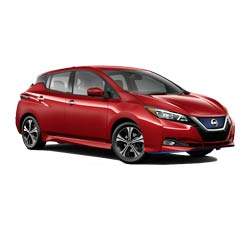2022 Nissan LEAF Pros vs Cons. Should You Buy?
The Nissan LEAF has made waves in the automotive industry, leaving gas-powered vehicles in its dust as one of the first widely known electric automobiles. Drivers are becoming increasingly aware of all that this sophisticated vehicle can offer - from efficiency to environmental benefits. With a new and improved 2022 model entering into competition with other EV providers, it'll be interesting to see if drivers opt for the trusty LEAF or explore greener pastures elsewhere. This guide will certainly help shed light on what's available so car lovers can make an informed decision when searching for their next ride.
What's New for 2022?
Nissan has made the LEAF one of the best options for an all-electric vehicle by slashing over $4K off its price and equipping it with CHAdeMO fast charging as a standard across trim levels. The SV Plus model is particularly exciting, providing customers with ProPilot Assist – a semi-autonomous driving mode that offers smoother rides than ever before. With these new features, Nissan's electric future looks brighter every day.
Top 10 Reasons to Buy a 2022 Nissan LEAF – The Pros
1. No More Visits to the Gas Station
Driving a Nissan LEAF is like driving through the future. With no tailpipe emissions, an electric motor under the hood and powered by a rechargeable battery pack, there's practically nothing standing in your way of freedom -- except for charging up once in awhile! Enjoy zipping around without any guilt about damaging air or noise pollution; this may be what transportation looks like tomorrow.
2. Requires Less Maintenance
With an electric vehicle, goodbye to costly and time consuming oil changes! Say farewell to having to replace spark plugs and timing belts - a sign of the times as EVs rise in popularity. No more trips down memory lane just for routine maintenance checks; with these vehicles you can drive confidently knowing that less attention is needed under the hood.
3. The e-Pedal Is Fun to Use
If you're looking for something exciting and different, then why not give the 2022 Nissan LEAF a test drive? The e-Pedal is incredibly responsive - just push down to accelerate quickly! For slowing down, ease up on the pedal instead of hitting your traditional brake. You might find that this model's deceleration will surprise you in how powerful it can be. With enough practice using only one pedal, soon driving like a pro could become second nature.
4. Two Battery Choices
With two battery options available, drivers can decide what's best for them. The standard 40 kWh battery offers enough range for everyday commutes and errands with a 149 mile span. For those needing to venture further out of town or are always on the go, there is an optional 62 kWh pack that will take you 226 miles!
5. Larger Battery Packs a Punch
With the 62 kWh battery, there's plenty of kick. This larger battery allows the vehicle to have 214 horsepower. This is a solid amount of power, especially given the fact that the LEAF is a compact car. With this battery, the Nissan should quickly get up to speed after being at a stop sign or a stop light.
6. The Charging Process Is Easy
With the Nissan LEAF, driving an electric vehicle is a breeze. Refueling with energy is simplicity itself - all it takes is connecting to the charge port beneath your car's hood just like you would at any gas station and in no time whatsoever, your ride will be good as new! Plus modern cars can recognize when they’re full-charged so there won't ever be a chance of overcharging – or if preferred you always have manual control too.
7. Many Places to Charge
Most people, if they're able, charge their electric vehicles at home. Overnight charging is usually very convenient and doesn't interfere with daily routines. People can choose to use regular 120-volt outlets, or they can upgrade to 240-volt systems. With a 240-volt system, it can take eight hours to fully charge the 40 kWh battery and 11.5 hours to fully charge the larger battery.
8. A Versatile Cabin
Versatile and neat - this car packs a punch in convenience. With just the push of a button, its rear seats quickly fold down to give occupants an impressive cargo space increase from 23.6 cubic feet up to 30! Those same versatile backseats are split 60/40 if you only need extra space on one side – no problem! It's definitely compact when it comes time for parking, but there's plenty of room inside too.
9. High-Tech Equipment
Driving the Nissan LEAF puts you in command of a wealth of exclusive, high-tech features. With its 8 inch touchscreen display for effortless navigation and integration with smartphones/smartwatches that let drivers regulate cabin climate or check range status remotely - right from their phones! This revolutionary tech brings extreme comfort to any journey.
10. Keeping Passengers Safe
The Nissan LEAF is not just a driver's vehicle; it also has its own set of eyes! With the standard automatic emergency braking, forward collision alert, blind spot monitoring and lane departure warning systems in place to monitor potential problems on your behalf. In this way you can be sure that no matter what surprises may come up during your journey - the car will always have an extra pair of ‘eyes’ at hand – helping make every drive safe and stress-free.
Reasons Not to Buy a 2022 Nissan LEAF – The Cons
1. Standard Battery Is Limited
With the standard 40 kWh battery, power and range are limited. Horsepower is 147, which is decent but not impressive by any means. Range is 149 miles. While this is sufficient for local trips, it may cause some concern among those who plan on taking their cars for long road trips. It can be pretty inconvenient to have to stop to charge a battery every two or three hours, and people would have to locate so many charging stops along their route.
2. Small Second Row
The back seat in the Nissan LEAF is quite small, offering only 33.5 inches of leg room. Adults might not be that comfortable sitting in the back of this model, so this may be a problem for certain buyers.
3. Not Extremely Sophisticated
At the top of Nissan LEAF range sits its SL Plus trim - with leather seating and heated front seats as standard, you'll be traveling in style and comfort. Unfortunately though, it misses out on some elements found at higher levels such as ventilated chairs and a memory driver's seat feature that allow for tailored settings to suit your needs each time.
Conclusion
The 2022 Nissan LEAF is the ideal car choice for budget-minded drivers looking to make their transition into an all-electric lifestyle. Available in two engine variants, it provides personalized performance options when it comes to power and range capabilities. Plus, with built-in driver assist systems plus comprehensive infotainment packages at a great price point - this model has never been more accessible or attractive.
• 2022 Nissan Altima
• 2022 Nissan Armada
• 2022 Nissan Frontier
• 2022 Nissan Kicks
• 2022 Nissan LEAF
• 2022 Nissan Maxima
• 2022 Nissan Murano
• 2022 Nissan Pathfinder
• 2022 Nissan Rogue
• 2022 Nissan Rogue Sport
• 2022 Nissan Sentra
• 2022 Nissan Titan
• 2022 Nissan Titan XD
• 2022 Nissan Versa


